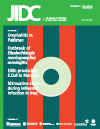A case report and literature review: osteomyelitis caused by community-associated methicillin resistant Staphylococcus aureus
DOI:
https://doi.org/10.3855/jidc.1633Keywords:
Staphylococcus aureus, osteomyelitis, community-associated, methicillin resistantAbstract
Osteomyelitis in adolescents is a serious disease with the potential for lifelong disability. The key to successful management is early diagnosis, including bone sampling for microbiological and pathological examination to allow targeted and long-lasting antibiotic therapy. Staphylococcus aureus is the most frequently isolated microorganism in these patients. Methicillin-resistant S. aureus (MRSA) is usually considered a nosocomial pathogen, but increasingly it is acquired in the community. We present a case of acute osteomyelitis caused by community-associated MRSA (CA-MRSA) who had never been hospitalized and had no other known risk factors for MRSA. The changing epidemiology of MRSA became evident when infections occurred in previously healthy patients without established risk factors. MRSA infections have been increasingly reported in pediatric patients, but they are uncommon in adults. Skin and soft tissue infections remain the most common manifestations of CA-MRSA infections. Glycopeptides can be used as initial therapy and oral trimetoprim-sulfamethoxazole as sequential therapy for these patients.
Downloads
Published
How to Cite
Issue
Section
License
Authors who publish with this journal agree to the following terms:
- Authors retain copyright and grant the journal right of first publication with the work simultaneously licensed under a Creative Commons Attribution License that allows others to share the work with an acknowledgement of the work's authorship and initial publication in this journal.
- Authors are able to enter into separate, additional contractual arrangements for the non-exclusive distribution of the journal's published version of the work (e.g., post it to an institutional repository or publish it in a book), with an acknowledgement of its initial publication in this journal.
- Authors are permitted and encouraged to post their work online (e.g., in institutional repositories or on their website) prior to and during the submission process, as it can lead to productive exchanges, as well as earlier and greater citation of published work (See The Effect of Open Access).








